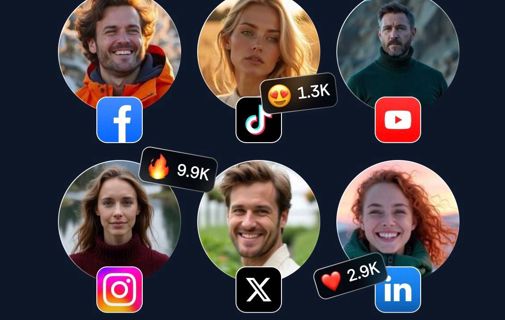
Online presence has become more visual than verbal. Whether someone is browsing your Instagram grid, checking your LinkedIn profile, or scrolling through your creative portfolio, the image they see of you often shapes their impression before they even read a word.
But not all portraits work. Flat lighting, generic backgrounds, or over-filtered selfies send the wrong signal. On the other hand, a well-crafted, realistic portrait—one that looks like it was taken by someone who knows how to use a camera—builds trust instantly. And with the rise of AI-generated photo-realistic portraits, this kind of image is no longer reserved for those with access to expensive shoots or scenic locations.
Why People Are Moving Away From Over-Edited Photos
The golden hour glow, the dramatic blur, the face-smoothing presets—people have seen it all, and frankly, most are tuning it out.
What’s cutting through the noise now are images that feel grounded. Not raw and messy, but refined in a way that still feels real. That might mean a natural background, soft lighting that matches your skin tone, or a setting that looks like somewhere you could’ve actually stood.
Authenticity doesn’t mean no editing—it means the editing doesn’t distract. Instead of wiping out texture or dropping in neon colors, the best portraits now highlight character. They don’t flatten you; they bring depth.
Social Media Craves Something More Human
People used to post to impress. Now they post to connect. And that shift shows up in the kinds of images that perform best.
Take Instagram. A clean, well-lit portrait in a believable outdoor setting almost always gets more engagement than another mirror selfie or high-gloss filter job. It feels different. It looks intentional. Same goes for platforms like TikTok and Facebook, where the image you choose for your profile or thumbnail can influence whether someone watches, follows, or skips.
These platforms have matured, and so have the users. They’re looking for substance—even in visuals. A sharp, natural-looking portrait that matches your tone? That’s one of the simplest ways to set the right impression fast.
Why AI Is Quietly Redefining the Portrait Game
Here’s the truth: most people don’t have access to a professional photographer, a good camera, or a location worth shooting in. That used to be a hard limitation. Now, it isn’t.
AI tools have made it possible to Generate nature-inspired portraits that look like they were captured outdoors, in real light, with proper camera depth. And they’re convincing—not in a staged or cartoonish way, but in the kind of way where someone might ask, “Where did you take that?”
What makes this different from slapping on a background filter is that advanced AI systems adjust lighting, facial shadows, and contrast to fit the environment. If your portrait is dropped into a field at golden hour, your skin tone reflects it. If the setting is snowy and crisp, your features adjust accordingly. The goal is visual cohesion—and when it works, it really works.
That’s why tools like this AI nature portrait generator are gaining ground. They don’t just change the setting—they make it believable. And that’s what people care about.
It’s Not Just for Social — It’s for Your Brand
Whether you’re a photographer, designer, writer, coach, or consultant, your photo appears in more places than you think.
Website “About” pages, bios in pitch decks, speaker slides, digital resumes, email footers—every one of these is a touchpoint. If the image you use feels stock, too casual, or low-effort, it sets the wrong tone. But drop in a portrait that’s clean, professionally styled, and visually compelling—and suddenly, you look prepared. Clear. Present.
AI-enhanced portraits are making it easier to bridge that gap. You don’t need to fake being someone you’re not. You just need to present your best, realistic self in a setting that reflects your tone and style.
The Psychology Behind a Strong Portrait
People don’t always realize they’re reacting to your photo. But they are.
A background that looks like a real location adds depth and makes you more relatable. Balanced lighting makes you feel trustworthy. Natural facial detail—not overly smoothed—signals authenticity. All of this happens in milliseconds, often before someone even reads your name.
This is especially true for creatives, freelancers, and personal brands. A strong portrait doesn’t just show your face—it shows your attention to detail. It tells clients and collaborators that you know how to present well, that you care about first impressions, and that you’re thoughtful in your choices.
Final Thoughts: Real, Clean, and Adaptable Wins
There’s no single perfect image that works everywhere. But a sharp, realistic portrait that looks like it was taken outdoors, with care and natural light—that’s about as close as it gets.
These kinds of images are flexible. They work on a personal blog and a professional platform. They look good in a casual grid and inside a polished portfolio. And when they’re created with smart AI, they don’t look artificial. They just look right.
Your image travels further than you think. So make it one that feels real—and reflects how you actually want to be seen.
0 件のコメント
この投稿にコメントしよう!
この投稿にはまだコメントがありません。
ぜひあなたの声を聞かせてください。
